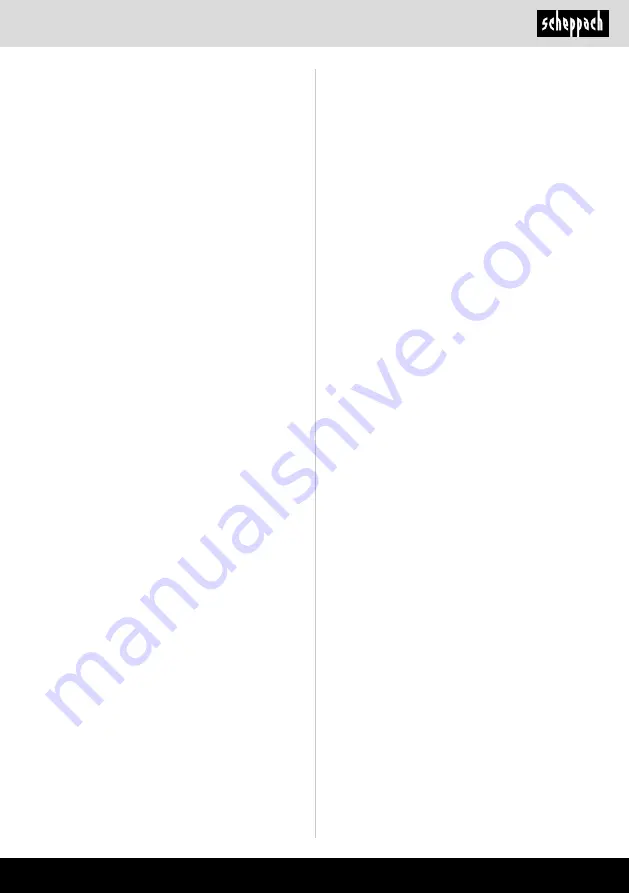
www.scheppach.com
GB | 23
Safety instructions for working with compressed
air and blasting guns:
•
Ensure there is sufficient distance to the product, at
least 2.50 m, and keep the compressed air tools /
compressed air attachments away from the com-
pressor during operation.
• The compressor pump and lines can become very
hot during operation. Touching these parts will burn
you.
• The air which is sucked in by the compressor must
be kept free of impurities that could cause fires or
explosions in the compressor pump.
• When releasing the hose coupling, hold the hose
coupling piece with your hand. This way, you can
protect yourself against injury from the rebounding
hose.
• Wear safety goggles when working with the blow-
out pistol.
Foreign objects or blown off parts can
easily cause injuries.
• Wear safety goggles and a respirator when working
with the compressed air pistol. Dusts are harmful to
health!
Foreign objects or blown off parts can easily
cause injuries.
• Do not blow at people with the blow-out pistol and
do not clean clothes while being worn. Risk of injury!
Safety instructions when using spraying attach-
ments (e.g. paint sprayers):
1. Keep the spray attachment away from the com-
pressor when filling so that no liquid comes into
contact with the compressor.
2. Never spray in the direction of the compressor
when using the spraying attachments (e.g. paint
sprayers). Moisture can lead to electrical hazards!
3.
Do not process any paints or solvents with a flash
point below 55° C. Risk of explosion!
4. Do not heat up paints or solvents. Risk of explo-
sion!
5. If hazardous liquids are processed, wear protec-
tive filter units (face guards).
Also, adhere to the
safety information provided by the manufacturers
of such liquids.
6. The details and designations of the Ordinance on
Hazardous Substances, which are displayed on
the outer packaging of the processed material,
must be observed. Additional protective measures
are to be undertaken if necessary, particularly the
wearing of suitable clothing and masks.
3. Check the power tool for potential damage
- Protective devices or other parts with minor dam-
age must be carefully inspected to ensure that
they function correctly and as intended prior to
continued use of the power tool.
- Check whether the moving parts function faultless-
ly and do not jam or whether parts are damaged.
All parts must be correctly mounted and all condi-
tions must be fulfilled to ensure fault-free opera
-
tion of the power tool.
- Damaged protective devices and parts must be
properly repaired or replaced by a recognised
workshop, insofar as nothing different is specified
in the operating manual.
- Do not use any faulty or damaged connection
cables.
4.
Attention!
- For your own safety, only use accessories and
additional equipment that are indicated in the
operating manual or have been recommended or
indicated by the manufacturer. Use of other tools
or accessories that those recommended in the
operating manual or in the catalogue could rep-
resent a personal danger to you.
5. Replacing the connection line
- If the connection line is damaged, it must be re-
placed by the manufacturer or an electrician to
avoid danger. There is a risk of electric shock.
6.
Inflating tyres
-
Directly after inflating tyres, check the pressure
with a suitable pressure gauge, for example at
your filling station.
7. Street-legal compressors in construction site op-
eration
-
Ensure that all hoses and fixtures are suitable for
the maximum permissible working pressure of the
compressor.
8. Set-up location
-
Only set up the compressor on a flat surface.
9. It is recommended to equip the feed hoses with a
safety cable in cases where the pressure is above
7 bar, e.g. using a wire cable.
10. Avoid over-stressing the piping system by using
flexible hose connections to prevent kinking.
ADDITIONAL SAFETY INSTRUCTIONS
Observe the corresponding operating manuals of
the respective compressed air tools / compressed
air attachments!
The following general instructions
must also be observed:
















































